Deny it all you want, but the fact remains that the world is slowly warming up, and if we don’t take steps to stem it now, the damage will be enormous and irreversible
The reason behind this ‘global warming‘ is because of the carbon-based fossil fuels we use in power plants and vehicular engines. When these fuels are used, carbon dioxide and other greenhouse gases are emitted, and these gases lead to climate change.
Over the last two hundred years or so after the Industrial Revolution, the world has been using fossil fuels at an unprecedented rate and not only has this severely depleted the world’s reserves of fossil fuels, it’s an effect on climate change has been immense. Just one look at how much the polar ice caps have shrunk is enough to demonstrate the extent of the damage.
What is a Carbon Footprint?
The combination of harmful emissions caused by using fossil fuels in your home, vehicles, and everyday activities is known as your “carbon footprint”.
Although there are several ways to reduce your carbon footprint, like using electric cars, using compact fluorescent lights, or eating local, non-processed food, living a completely carbon free life is a near impossibility in today’s times.
What are Carbon Offsets?
Carbon offsets are a practical and efficient way to fight climate change and promote the use of renewable energy. Not only do you reduce your own carbon footprint, but you also contribute to a more sustainable future.
Specifically, carbon offsetting means compensating for the carbon-dioxide pollution you’re causing, by preventing the same amount of pollution from happening somewhere else.
To put it in numbers, one carbon offset means compensating for emitting one tonne of carbon dioxide (CO2) into the atmosphere by preventing one tonne of CO2 from entering the atmosphere elsewhere on Earth.
How Do You Do This?
The methods are several – but the basic principle is the same.
- You either prevent one tonne of carbon dioxide being released somewhere. (For example, by investing in renewable energy)
- Or, you remove one tonne of carbon dioxide from the air. (For example, by planting more trees, as trees reduce carbon emissions.)
The whole point of this enterprise is to match precisely the “carbon damage” done in one place with “carbon repair” in a different place so that your net carbon footprint is zero.
What is the Purpose of Carbon Offsets?
Carbon offsetting, in theory, makes a huge difference in helping the world tackle the threat of global warming. Although it doesn’t cure the problem, it stops it from getting worse.
The bulk of environmental damage is perpetrated by governments and big corporations. Hence the onus falls on them to make up for it too.
Carbon offset credits purchased by companies go to funding environmental projects which would not have happened by themselves. It’s because of the money invested by these companies that these projects (such as the planting of forests or the inception of a wind energy electricity generator) come to pass.
Good offsets can make a huge difference. For example, if you offset by investing in a tidal or solar project, you’re adding to the overall supply of renewable energy, which leads to a reduction in the amount of fossil fuels consumed in future.
Thus, you pave the path to a more sustainable future, and you stop the problem of global warming from getting worse.
Conclusion
As an individual, you can do your part too. You could plant some trees in the land you own, or you could campaign for more planting of trees or renewable energy. Thus, in theory, even one man can possibly reduce his carbon emissions to zero.
There can be co-existing benefits as well. If your offset payment helps to plant trees in a wildlife reserve, for example, it will create a larger habitat for animals and help biodiversity as well.
